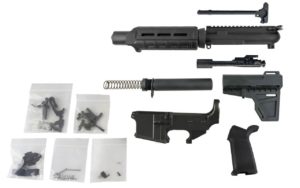How to Legally Build a Short Barreled Rifle
Posted by Gun Builders Depot on Apr 16th 2018
Strict legal requirements make owning an SBR a pain in the ass, so we decided to make it a little easier. Below is a guide that'll help you figure out how to legally build a short-barreled rifle at home. We're using an 80 percent lower/stripped AR-15 lower receiver for this guide. This approach is great because you're building your SBR at home, not buying it from a gun store.
Building your SBR = Less ATF paperwork
That means you don't have to worry about ATF Form 4 and transferring an SBR from an FFL to yourself. You also don't have to wait until that $200 tax stamp to arrives in the mail to start building. You can start now by building your SBR as an AR pistol. You'll convert it to an SBR once your paperwork has been received.
As always, we're not lawyers. It's up to you to seek legal advice regarding the NFA and your state's own laws governing the sale and ownership of SBRs.
The steps
Here are the steps you must take to legally build an SBR at home:
- Buy an 80 percent lower or AR-15 stripped lower.
- Engrave the lower with identifying information.
- Get your fingerprints taken on ATF Fingerprint Card FD-258.
- Fill out an Application to Make and Register a Firearm (ATF Form 1).
- Build your AR pistol and enjoy it while you wait for the paperwork to clear.
- Receive your $200 Tax Stamp paperwork from the ATF.
- Convert your AR pistol into your own SBR!
Step 1: Buy an 80 percent lower or stripped lower![]()
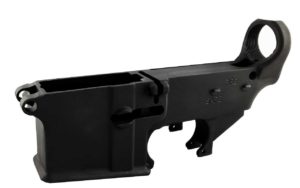 This is the easy part. You'll need to pick out the 80 percent lower (or stripped lower) you'll use to build your AR pistol/future SBR. If you have a good idea of how you want to build your SBR, you can also start buying all the other parts you need (minus a buttstock). You'll need to report the barrel length and overall length on ATF Form 1, so make sure you pick the barrel and upper you want before filing your paperwork.
This is the easy part. You'll need to pick out the 80 percent lower (or stripped lower) you'll use to build your AR pistol/future SBR. If you have a good idea of how you want to build your SBR, you can also start buying all the other parts you need (minus a buttstock). You'll need to report the barrel length and overall length on ATF Form 1, so make sure you pick the barrel and upper you want before filing your paperwork.
Step 2: Get your 80 percent lower engraved
The ATF requires that your pistol/future SBR has appropriate engravings for the paperwork. The engravings must be at least 0.003"" deep and the text no smaller than 1/16"" high. You'll need to engrave your lower with the following information:
- Name of maker of the gun (that's you!)
- Location (city and state where you, the maker, live)
- Caliber (""MULTI"" no longer works, you must engrave the actual caliber)
- Serial Number (001 works for your first NFA item, or 666 if you're feeling frisky)
- Model Number (if you include a model number on your Form 1 it must also be engraved)
Because your 80 percent lower isn't considered a firearm, any machine shop can engrave it for you. They simply need to follow the guidelines provided by Federal law.
Step 3: Fingerprints
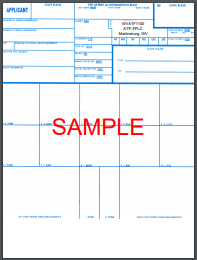
[ ATF Fingerprint Card FD-258]
The ATF requires that you have your fingerprints taken and recorded using their own form, Fingerprint Card FD-258. Here's a sample of what the form looks like. Unfortunately, you can't download FD-258. You must contact the ATF to receive one. You can call them (703-870-7526) or request one online.
Your local law enforcement agency must collect your fingerprints on two FD-258 Fingerprint Cards. It's best to call your local police department's non-emergency number to set up an appointment. This is also a good time to ask them to get you in touch with your Chief Local Law Enforcement Officer (CLEO). You'll need to mail ATF Form 1 to him or her in the next step.
Step 4: Fill out and submit ATF Form 1
[Click to download Form 1 from ATF]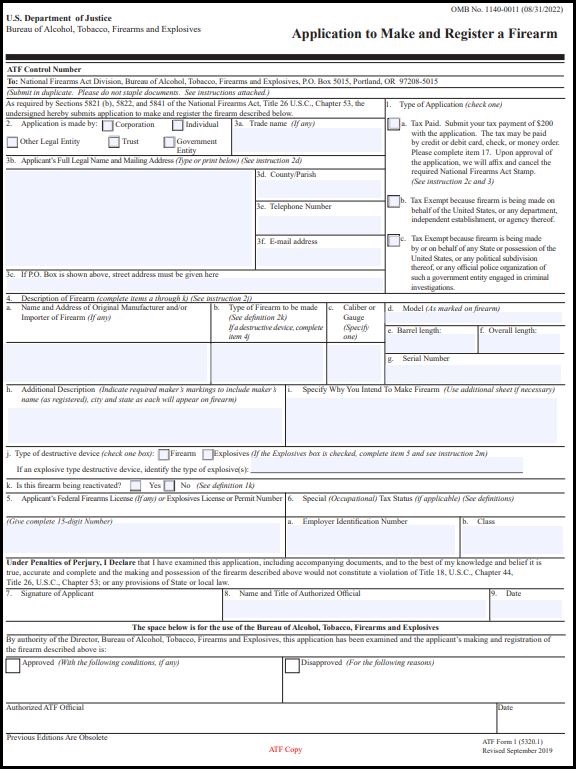
Now we're getting somewhere! You'll need to download and fill out ATF Form 1 ( click here for the latest version). There are (3) copies of ATF Form 1 in the download. You must complete all three. At the bottom of each copy, you'll find a red notation indicating where that copy is supposed to go. Two copies will go to the ATF, and one copy will go to your CLEO.
You'll need two completed fingerprint cards, $200 (debit/credit, cash or money order), and two copies of a recent 2"" x 2"" passport photo to attach to Form 1 with tape or glue ( don't staple). Your fingerprints and passport photos will only be attached to the ATF's copies of Form 1. You don't need either for your CLEO's copy of ATF Form 1.
Whenever ATF Form 1 requests information about your SBR's ""original manufacturer"" or ""importer"", you'll be providing your own information. You're building, not buying, so you are the manufacturer.
If you're having a hard time filling out Form 1 or aren't sure what to write, check out this instructional video provided by an attorney and gun enthusiast. ATF Form 1 allows you to input your credit/debit card info for payment. If you prefer to pay by check or money order, it must be included with Form 1 when you mail it.
Mail your ATF copies of Form 1 to:
National Firearms Act Division (ATF Forms 1 and 4)
P.O. Box 5015
Portland, OR 97208-5015
Step 5: Build your AR pistol while you wait
[An AR-15 Pistol Kit like work perfect for an SBR build. Most kits include an 80% lower.]
After this is all submitted you have to play the waiting game - roughly six to nine months. This is where we plug our own recommendation:
It's great to fill that free time by building your soon-to-be SBR as an AR 15 pistol. We recommend starting with a pistol instead of a rifle. It's cheaper and easier to add a rifle buffer tube and buttstock to complete your SBR, instead of building a rifle and swapping the swapping barrel out for a shorter model.
Remember, you need to report barrel length and total length to the ATF when you fill out Form 1. A pistol will already be correctly sized up for reporting on Form 1.
Step 6: Get your Tax Stamp and add a buttstock
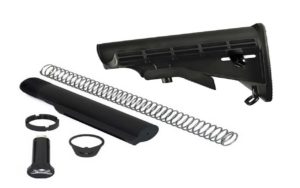
Once your Tax Stamp comes in the mail from the ATF, you'll know that Form 1 was accepted and approved. You can now add an adjustable buffer tube and buttstock to your AR pistol, converting it to an SBR.
That's it! You've built an SBR.
You now have a wicked, maneuverable rifle that's compact and lightweight! SBRs are just downright cool as Hell, and they make excellent self-defense rifles. They're perfect for home defense, too. With an 80 lower, an AR 15 pistol kit, and a little bit of patience, you can have nearly the same type of rifle used and loved by ODA, Frogmen and Special Operations worldwide - all that's missing now is a "giggle" switch, but that's another topic for another day. Stay frosty.
DISCLAIMER: If you are new to the world of DIY gun building, you likely have a lot of questions and rightfully so. It’s an area that has a lot of questions that, without the correct answers, could have some serious implications. At GunBuilders.com, we are by no means providing this content on our website to serve as legal advice or legal counsel. We encourage each and every builder to perform their own research around their respective State laws as well as educating themselves on the Federal laws. When performing your own research, please be sure that you are getting your information from a reliable source.

